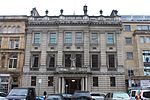Princes Street Gardens

Princes Street Gardens are two adjacent public parks in the centre of Edinburgh, Scotland, lying in the shadow of Edinburgh Castle. The Gardens were created in the 1820s following the long draining of the Nor Loch and building of the New Town, beginning in the 1760s. The loch, situated on the north side of the town, was originally an artificial creation forming part of its medieval defences and made expansion northwards difficult. The water was habitually polluted from sewage draining downhill from the Old Town. The gardens run along the south side of Princes Street and are divided by The Mound, on which the National Gallery of Scotland and the Royal Scottish Academy buildings are located. East Princes Street Gardens run from The Mound to Waverley Bridge, and cover 8.5 acres (3.4 ha). The larger West Princes Street Gardens cover 29 acres (12 ha) and extend to the adjacent churches of St. John's and St. Cuthbert's, near Lothian Road in the west. In 1846 the railway was built in the valley to connect the Edinburgh-Glasgow line at Haymarket with the new northern terminus of the North British line from Berwick-upon-Tweed at Waverley Station.The Gardens are the best known parks in Edinburgh, having the highest awareness and visitor figures for both residents and visitors to the city.
Excerpt from the Wikipedia article Princes Street Gardens (License: CC BY-SA 3.0, Authors, Images).Princes Street Gardens
West Footbridge, City of Edinburgh Old Town
Geographical coordinates (GPS) Address Nearby Places Show on map
Geographical coordinates (GPS)
| Latitude | Longitude |
|---|---|
| N 55.95005 ° | E -3.2029944444444 ° |
Address
Ross Fountain
West Footbridge
EH1 2EW City of Edinburgh, Old Town
Scotland, United Kingdom
Open on Google Maps










